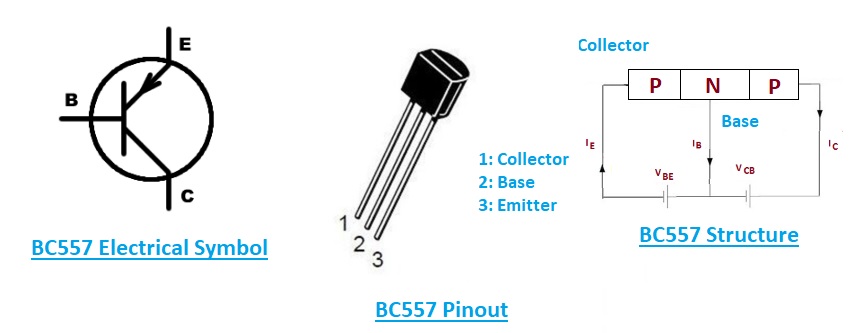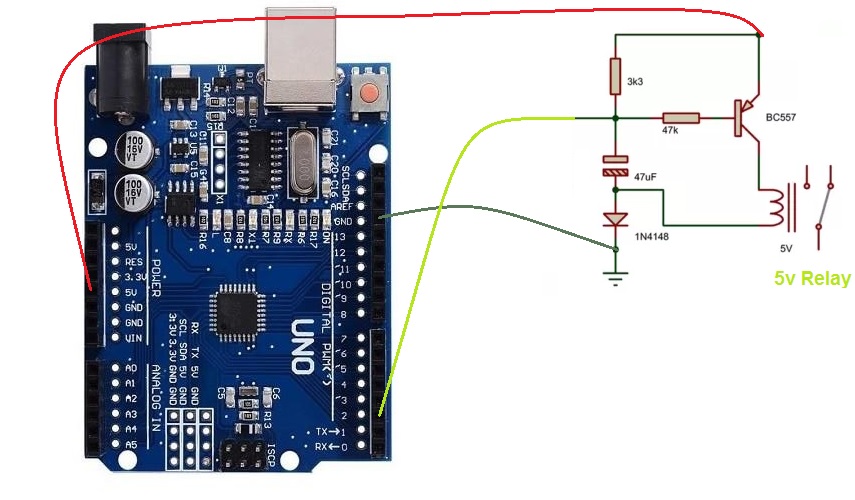AED 1.05
Description
BC557 is a PNP bipolar junction transistor that is commonly used in low-power amplification and switching circuits. It has a maximum current rating of 100 mA and a maximum voltage rating of 45 V. The BC557 transistor has three pins: an emitter, base, and collector, and is housed in a TO-92 package. It is often used in applications such as audio amplifiers, voltage regulators, and power switches.
Package Includes:
- 1 x BC557 PNP bipolar junction transistor
Features:
- PNP transistor
- Low noise and high gain
- Suitable for general-purpose switching and amplification
- Low saturation voltage
- Available in various package types, including TO-92, SOT-23, and SOT-223
- The maximum collector current of 100 mA
- The maximum collector-emitter voltage of 45 V
- Maximum power dissipation of 500 mW
- Suitable for use in low-power circuits and battery-powered applications
Description:
The BC557 is a PNP bipolar junction transistor (BJT) that is widely used in electronic circuits for amplification and switching purposes. It is a versatile transistor that has a variety of applications in audio amplifiers, voltage regulators, power supplies, and electronic control circuits. One of the key features of the BC557 is its low noise and high gain characteristics, which make it well-suited for use in audio amplifier circuits. The transistor has a maximum current rating of 100mA and a maximum voltage rating of 45V, which makes it suitable for use in low-power applications. The BC557 is a small-signal transistor that operates in the low-frequency range, typically up to a few hundred kilohertz. It has a collector-emitter saturation voltage of around 0.7V, which means that it can be used as a switch in circuits that require low voltage drops. The transistor is housed in a TO-92 package, which is a small plastic package that is easy to mount on a printed circuit board (PCB). The pinout of the transistor is standard for most PNP BJTs, with the collector being the pin closest to the flat side of the package, followed by the base pin, and then the emitter pin.
Principle of Work:
The BC557 is a PNP bipolar junction transistor (BJT), which means that it consists of three layers of doped semiconductor material. The center layer is called the base, and the outer layers are called the emitter and collector. When a small current flows into the base, the transistor allows a much larger current to flow from the collector to the emitter. In the case of the BC557, when a small current is applied to the base, it causes the transistor to switch on and allow current to flow from the collector to the emitter. The BC557 is known for its high current gain, meaning that a small change in the base current can result in a large change in the collector current. The BC557 is commonly used in low-power applications such as audio amplification and switching, as well as in voltage regulator circuits. Its small size and high current gain make it a popular choice for use in portable electronic devices. It is important to note that the BC557 is a PNP transistor, which means that it is used in circuits with a negative ground or power supply. In contrast, an NPN transistor would be used in circuits with a positive ground or power supply.
Pinout of the Transistor:

The BC557 is a three-layer PNP transistor, which means it has a collector (C), base (B), and emitter (E) terminal. The pins are arranged in a triangular configuration, with the flat side facing the observer.
- The collector (C) is the pin on the left-hand side of the triangular configuration when the flat side is facing up. This terminal collects the majority of charge carriers, which are positively charged in a PNP transistor.
- The base (B) is the center pin and is used to control the flow of current between the collector and emitter. It acts as a gate, controlling the flow of charge carriers between the collector and emitter terminals.
- The emitter (E) is the pin on the right-hand side of the triangular configuration when the flat side is facing up. This terminal emits the majority of charge carriers that are injected by the base terminal.
Applications:
- Audio Amplification: The BC557 transistor can be used as an audio amplifier in low-power applications. It can be used in the pre-amplifier stage or as a driver stage in small audio systems.
- Switching: The BC557 transistor can be used as a switch to control the flow of current in electronic circuits. It is commonly used in digital and analog circuits as a switch.
- Voltage Regulators: The BC557 transistor can be used as a voltage regulator to maintain a constant voltage level in electronic circuits.
- Oscillators: The BC557 transistor can be used in oscillator circuits to generate a signal at a specific frequency.
- LED Drivers: The BC557 transistor can be used as an LED driver to control the brightness of an LED or a group of LEDs in electronic circuits.
- Relay Drivers: The BC557 transistor can be used as a relay driver in electronic circuits to control the switching of a relay.
- Temperature Sensors: The BC557 transistor can be used as a temperature sensor in electronic circuits. It can be used in conjunction with other components to create a simple temperature-sensing circuit.
Circuit:
Here is how to make a relay circuit using a BC557 and 5v relay and some other basic components the base of the transistor connected to pin2 to control the relay

Library:
No need for a library.
Code:
An example code that allows you to control a relay using a serial monitor through a PNP transistor with the base connected to pin 2 on Arduino:
const int transistorPin = 2; // Pin 2 is connected to the base of the PNP transistor
void setup() {
pinMode(transistorPin, OUTPUT); // Set the transistor pin as an output
Serial.begin(9600); // Start serial communication at 9600 baud
}
void loop() {
if (Serial.available() > 0) {
int state = Serial.parseInt(); // Read the incoming data from serial and parse it as an integer
if (state == 0) {
digitalWrite(transistorPin, HIGH); // Turn off the transistor when receiving "0" from serial
} else if (state == 1) {
digitalWrite(transistorPin, LOW); // Turn on the transistor when receiving "1" from serial
}
}
}
To turn on the PNP transistor, send "1" from the serial monitor, and to turn it off, send "0". The code reads the incoming data from the serial and sets the transistor pin HIGH or LOW accordingly.
Technical Details:
- The type of package is T092
- The type of transistor is PNP
- Collector Current (IC) Max is -100mA
- Max Operating & Storage Temperature ranges from -65 to +150 degrees Centigrade
- Collector-Emitter Voltage or VCE Max is -45V
- DC current gain Max or Min (hFE) is 125 – 800
- Collector Base Voltage or VCB Max is-50V
- Max fT or Transition Frequency is 100 MHz
- Emitter-Base Voltage or VBE Max is -5V
- Collector Dissipation or Pc Max is 500 mW
- Peak Collector Current (Icm) is 200mA
- Junction Temperature (Tstg) is 150 Centigrade
Resources:
Comparisons:
The BC547 and BC557 are both general-purpose PNP and NPN bipolar junction transistors designed for amplification and switching applications. However, there are some differences between the two:
- Polarity: The BC547 is an NPN transistor, while the BC557 is a PNP transistor.
- Voltage and current ratings: The BC557 has a higher voltage rating and current handling capacity than the BC547. The maximum voltage rating for the BC557 is 45V, while for the BC547 it is 65V. The maximum collector current rating for the BC557 is 100mA, while for the BC547 it is 200mA.
- Gain: The hfe (current gain) of the BC557 is typically higher than that of the BC547.
- Packaging: Both transistors are available in a variety of packages, but the BC557 is also available in a surface-mount package.
- Applications: Due to their different polarity and voltage/current ratings, the BC547 and BC557 are used in different types of applications. The BC547 is commonly used in low-power switching and amplification circuits, while the BC557 is often used in higher voltage and current applications.
The BC547 and BC557 are similar in many ways, but their differences in polarity, voltage/current ratings, and gain make them better suited for different applications.